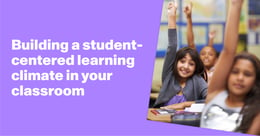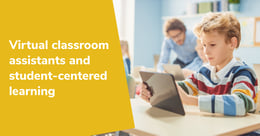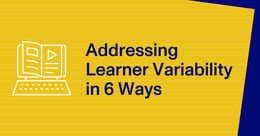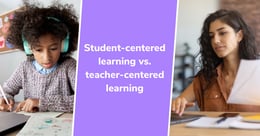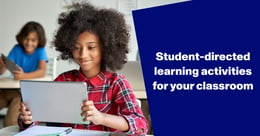
3 ways teachers can help develop lifelong learning skills for students
Whether their students are learning to count in kindergarten, polishing up their very first in-depth book report in middle school, or getting familiar with a difficult calculus formula later on in high school, it’s easy for educators to laser-focus on having students master the core concept at hand. However, it’s important to take the long view too. As seasoned teachers know, great instruction isn’t solely about having students understand grade-level concepts. It’s also about preparing learners for the ever-fluctuating world ahead of them—and whatever curveballs life throws their way.
Teachers, as lifelong learners themselves, can approach their work with the holistic aim of not only having students master what’s in the curriculum, but also helping them develop the lifelong learning skills they’ll need to thrive over the long term.
The importance of developing lifelong learning skills for students
A lifelong learning skill set encompasses the continuous “voluntary and self-motivated pursuit of knowledge” for both individual and professional reasons, according to a report on the increasing importance of continuous learning. This involves more than the simple act of learning and storing new information. In fact, true lifelong learners have made an ingrained habit of their intellectual pursuits.
The report’s authors mention that lifelong learning offers a variety of benefits, including boosting social connectedness, spurring personal development, and improving employability. At the same time, lifelong learners might even experience more positive health outcomes, according to a roundup of research on lifelong learning published by Harvard Business Review. With this, the myriad benefits of lifelong learning are certainly worth educators’ attention.
Lifelong learning encompasses the continuous ‘voluntary and self-motivated pursuit of knowledge’ for both individual and professional reasons.
Why should teachers foster a lasting love of learning?
Educators play an integral role when it comes to ensuring their K-12 students make learning into a lifelong habit. In fact, teachers who foster student agency and cultivate confidence on a daily basis boost their pupils’ drive to become lifelong learners as well as further their future personal, academic, and even professional growth.
But why look so far into the future if students have concepts they need to master today? With the speed of current technological breakthroughs lacking a historical precedent, today’s K-12 students can expect a near-constant need to learn even after they complete their schooling.
This means that fostering students’ lifelong learning skills can create well-rounded graduates. When students leave the classroom, they’re likely going to find themselves switching careers a few times given today’s fast-paced job market. Developing a lifelong curiosity and willingness to learn ensures students can stay ahead of the curve long after their school years.
3 techniques for developing students’ lifelong learning habits
Fostering lifelong learning skills for students might seem like an insurmountable task for educators who are trying to maintain their well-being in an already-challenging atmosphere. Thankfully, even small tweaks to lesson plans can set students on the path toward lasting confidence.
Next, we'll explore three techniques educators can integrate in their classrooms today to bolster students’ motivation and help them develop the drive to become lifelong learners.
1. Student-centered learning
Because they place pupils at the core of their learning experiences, student-centered learning climates are particularly effective for encouraging lifelong curiosity.
According to a primer on student-centered learning, this concept involves reworking the way students absorb information. Rather than being “passive receivers” of lessons and concepts, students act as decision-makers and leaders. The information they learn, the instructional methods teachers use, and the assessments that learners complete are informed by students’ preferences.
It’s no surprise that integrating student-centered learning approaches—and the heightened degree of agency they provide—pays dividends. According to a report on the future of student agency by the Organisation for Economic Co-operation and Development (OECD), when students have this kind of say over their learning, they’re more likely to show greater motivation to learn and map out solid learning objectives. The OECD further explains that students with agency “are also more likely to have ‘learned how to learn’—an invaluable skill that they can and will use throughout their lives.”
Indianapolis’ Purdue Polytechnic High School already reaps the benefits student-centered learning provides. In a specialized “Foundations” class, students learn about community challenges and work toward fresh solutions. Foundations students conduct research, map out solutions, present their findings to educators and the wider community, and complete self-evaluations throughout the process. Teachers serve as a guardrail, but the students are responsible for planning out processes, establishing timelines, and encouraging themselves.
How teachers can implement student-centered learning
- Conduct small-group discussions and select a student instructor: Pose an open-ended question to students and have them discuss in small groups. Afterward, have a volunteer from each group explain their group’s consensus to the class.
- Have students review each others’ written assignments: Create a quick writing assignment and rubric. After students complete this assignment, have them swap with one another for a peer review. Students can use the rubric to evaluate their classmates’ work.
- Center learning on students’ lived experiences: In a Northwest Evaluation Association (NWEA) opinion piece on fostering student agency in the classroom, the organization suggests aligning learning materials more closely with students’ contexts. How do your learning modules connect with students’ lived experiences? To start, the article suggests finding a story problem from a text, presenting it to your students, and then asking them which parts they related to. Then, flip this question around by asking students how they’d rewrite the story problem to be more applicable to their lives.
- Ensure students understand the “why” behind learning material: Similarly, NWEA also encourages educators to explain the overall relevance of learning the selected concepts and material: “Do your students know how [their learning] will connect to their daily lives?” they write. “Are they clear on where the learning path is going?” Students should be able to understand how lessons apply outside classroom walls.
2. Inquiry-based learning
“Education is not an affair of ‘telling’ and being told, but an active and constructive process,” American philosopher and education reformer John Dewey wrote in 1916. Just over 50 years later, Brazilian educator and philosopher Paulo Freire noted that “liberating education consists [of] acts of cognition” rather than static information transfers between teacher and student.
Clearly, this concept of inquiry-based learning has strong historical roots—and it’s still applicable in modern classrooms. But what does an inquiry-based approach look like today? In short, it involves asking thoughtful, deliberate questions to guide students rather than simply giving them the solution. When instructors help them draw connections among concepts or change directions in their thinking patterns, students gain a greater sense of understanding and confidence in their own abilities—imbuing them with a lasting sense of intellectual curiosity.
How teachers can implement inquiry-based instruction
- Teach a group inquiry-based lesson: When planning interactive lessons and class activities, leave ample space for students to come up with their own explorative questions. Education company Structural Learning uses a history discussion as an example in this article on inquiry-based learning. Students learn about a historical topic—in this case, the 1918 Spanish flu. Then, learners divide themselves into discussion groups to talk through how the historical pandemic was similar to or different from COVID-19, coming up with in-depth questions along the way.
- Reframe how students arrive at answers and solutions: Rather than providing answers directly, consider asking a series of tailored questions to help students uncover solutions on their own. At Paper™, our tutors achieve this by following the “Paper Method”—a holistic, theory-based instructional framework. Instead of providing answers or solving problems for students, tutors respond to students’ inquiries with questions that gauge existing knowledge and guide problem-solving.
[READ: “10 student-directed learning exercises to try with Paper™”]
What's the Paper Method? 🤔 It's a holistic, theory-based framework designed to help students get the most from every tutoring session.
— Paper (@paperlearning) July 6, 2022
See how the Paper Method aims to foster critical thinking skills, strengthen subject knowledge, and more 📚 #EdTech pic.twitter.com/ewMuu4CVXt
3. Confidence-building
Building confidence—which helps students trust themselves as they absorb new concepts—is another key lifelong learning technique teachers can focus on.
Educators know this well. Confident students are often more likely than shy pupils to speak up in class, get help when they need it, and pick up concepts relatively quickly as a result. Luckily, this sense of confidence is a state of being that can be cultivated.
How teachers can build an environment that bolsters confidence
- Turn focus away from mistakes: Correcting students immediately after they make mistakes can have a negative impact on their confidence. In an article on developing student confidence for the National Education Association, second-grade teacher Java Robinson suggests letting the student finish their thought and explaining gently that there’s a more efficient way to arrive at the answer. In this way, students will better understand how to approach their work.
- Encourage attainable goals: Learning can be overwhelming for students, but helping them set manageable goals—whether that’s mastering a small concept, improving on a skill, or something similar—can help them see incremental progress.
Ready to instill a lifelong love of learning in your students? Check out these tips on how to empower students in their learning journeys.

